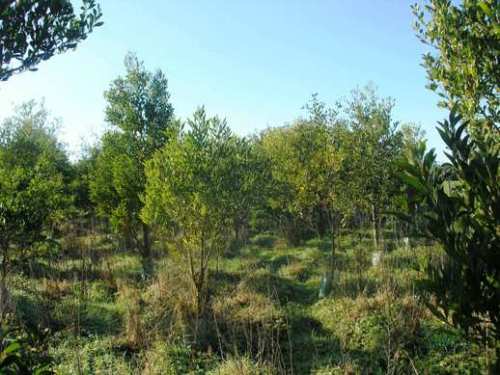Quilliam plantation
This is the second of two property reports from my recent trip north. This property is on the swampy flats near Smithton.
The soils are saturated for much of the year and there is little in the way of shelter.
If it was a greenfield site I would have advised caution in planting blackwood for wood production. The exposure to strong winds and the high water table present challenges in growing any trees, let alone tall, straight ones.
The property includes two block planting of almost pure blackwood at 3 metre spacing (1,111 trees per hectare) totalling about 1.5 ha, plus a considerable length of shelterbelt/drainside planting that includes a single row of blackwood at 3 metre spacing. The trees are up to 5 years of age. Protection from stock and wallabies was provided by electric fences and the common, soft-plastic tree guards shown in the picture. Obviously there can’t be too many wallabies about.
Despite the exposure and the rampant grass growth, the blackwoods are showing surprisingly good growth and form, particularly in the block plantings. My first response was “what would these trees look like with some weed control and pruning?” Weed control is certainly a problem when there is free-flowing water over the ground for at least half the year. So a single weed control in summer is needed once the ground has dried out, to get these trees growing quickly. The faster the growth the better the form.
Some of the trees are obviously no longer suitable for keeping due to lack of timely pruning, but there are still plenty of suitable trees from which to select the final crop, given that about 80% of the trees will need to be thinned to waste in the next 10 years.
The owner is unsure how to do the pruning, so I will be going back in a few weeks to help select the final crop trees and get them into shape with Mr. Quilliam’s help (and a new pair of gumboots!!).
Given the high water table and the exposure to strong winds there is a real risk of windthrow and crown breakage at this site. Planting at the higher stocking will help reduce that risk as the trees will quickly reach crown closure and help support each other. The trick will then be to gradually thin the trees at regular intervals, to retain near-full crown cover, while also allowing the trees to grow at the maximum possible rate. Leaving the windward row of blackwood trees unthinned and unpruned will also help provide protection and stability for the block plantings.
The combination of early crown closure, annual pruning and regular thinning should result in trees of excellent growth and form.
What then of the single-row blackwood plantings along the drains? I only saw a small section of these but I suspect tree form will not be so good. Given that part of the objective is for farm shelter, the best management may be to just prune and weed those trees that have the best form, and leave the rest to become big and branchy. Hopefully the unpruned shelter trees will help support the pruned trees in strong winds.
This blackwood planting was a great surprise. It was great that it is still young enough to be brought under good management. Also great that it demonstrates that even on wet exposed sites blackwood can grow very well. There are certainly challenges and risks ahead with windthrow and crown wind damage, but these are currently balanced by the positives of good growth and form.
I will give an update once the next pruning is completed. Stay tuned.

